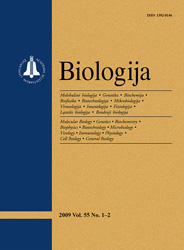Biologija / Biology
WHAT?
 ISSN 1392-0146 ISSN 2029-0578 (online) |
2006 m. Nr. 1 Analysis of DNA polymorphism in wild populations
of herb-Paris (Paris quadrifolia L., Trilliaceae) from
Lithuania and Norway
Analysis of random amplified polymorphic DNA (RAPD) was used to determine genetic diversity within the populations of herb-Paris plant from Lithuania and Norway. RAPD analyses have shown 21.9 ± 5.2% of polymorphic loci in the total sample. Polymorphism level in Norwegian sample was 20.3 ± 5.0%, and in the Lithuanian one was 21.9 ± 5.2%. The proportion of distinguishable RAPD phenotypes in Lithuania was 0.52 ± 0.03 and in Norway 0.24 ± 0.03. For the total sample, Shannon’s Information Index was 0.59 and Nei’s gene diversity 0.41. The estimated total proportion of diversity among populations (GST) and gene flow (Nm) were 0.67 and 0.245, respectively. In Norway GST was 0.64 and Nm was 0.28, whereas in Lithuania GST was 0.42 and Nm was 0.68. The UPGMA analyses have revealed that Lithuanian and Norwegian populations of herb-Paris are clearly separated into two clusters. Analysis of molecular variance (AMOVA) showed that the majority of molecular variation (41%) was due to variation between geographical regions (Lithuania and Norway), 37% of molecular variation was due to variation among individuals within the populations, and only 22% of variation was estimated to be due to variation between populations. In Lithuania, 68% of molecular variation was due to variation within populations, 32% due to variation between populations (ФPT = 0.32), whereas in Norway the proportions were 49% and 51% (ФPT = 0.51), respectively. Thus, the estimated parameters indicated a higher genetic diversity in Lithuanian populations of herb-Paris than in Norwegian ones.
Keywords: Paris quadrifolia, RAPD markers, genetic diversity |
Issues:
2011 - Vol.57 No. 1, No. 2, No. 3 2010 - Vol.56 No. 1-4 2009 - Vol.55 No. 1-2, No. 3-4 2008 - Vol.54 No. 1, No. 2, No. 3, No. 4 2007 - Vol.53 No. 1, No. 2, No. 3, No. 4 2006 No. 1, No. 2, No. 3, No. 4 2005 No. 1, No. 2, No. 3, No. 4 2004 No. 1, No. 2, No. 3, No. 4 2003 No. 1, No. 2, No. 3, No. 4 2002 No. 1, No. 2, No. 3, No. 4 2001 No. 1, No. 2, No. 3, No. 4 |